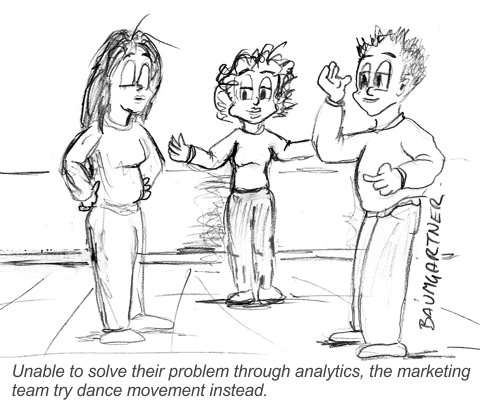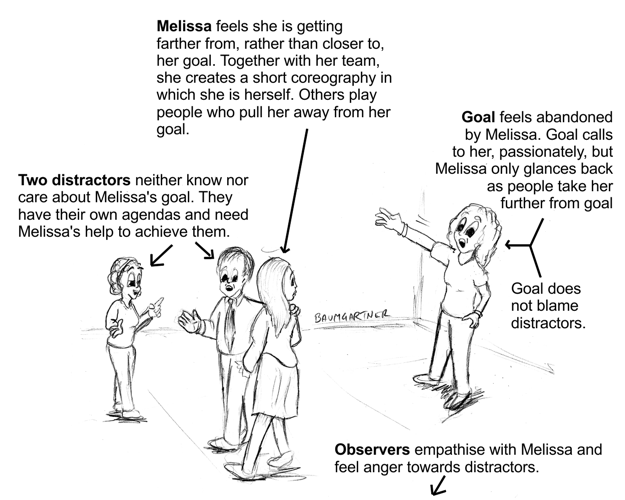
Got a Problem? Dance!
A new approach to understanding and solving problems
By Jeffrey Baumgartner
As I am sure I do not need to tell you, one of the most important things you need to do when trying to solve a problem, either through creativity or otherwise, is to understand the problem. So many problems are poorly solved because fools rush in with solutions that solve a completely different problem than the one confronting them.
Sadly, most problem understanding methodologies are not really very good at understanding the people aspect of problems. Sure, you can ask analytical questions like the five whys or collect data by the gigabyte. But analysis is different to understanding. Human behaviour is very much motivated by feelings, desires, fears and aspirations. Moreover, when more than one person is involved in a situation, there tends to be conflicting emotions, desires, fears and aspirations combined with a lack of empathy towards the others involved in the situation.
In order better to understand and solve such complex people situations, I teamed up with ace dance instructor (and friend) Elena Leibbrand and we built a workshop concept provisionally called "dynamic problem solving" (DPS) in which we use the language of movement, inspired by dance, to enable people to see problems in greater depth and experiment with solutions. We expected interesting results, nevertheless, we were amazed by the depth of insights we and others discovered using DPS in a trial workshop at the Brussels Imagination Club.
The Workshop
The following is closely based on our workshop, with names and a few details changed to protect the confidentiality of participants and clarify the process.
After a short introduction, Elena led the group through some warm up exercises that involved moving their bodies and making gestures to impersonate a wide range of things, from themselves being angry to being a photocopier or a jammed printer - really!
I followed with a short talk about problems, accepting personal responsibility for them and the need to play a role in solving the problem.
We then invited three people to share work or life related problems. Teams of five were formed around each problem and each team was instructed to use the language of movement, as we had practiced earlier, to create a short choreography about their problem. They were not allowed to use spoken word, though noises were allowed. Teams each found a quiet place to work. The problem owner explained the problem in more detail, others asked questions and then the the group collaborated in designing their choreographies. Elena and I coached the teams as they worked.
Melissa's Missing Goal
All of the choreographies were deeply insightful to the audience, the groups and the people who shared their problems, indeed everyone was surprised by the results. For this article, we'll focus on just one of the groups whose leader we'll call Melissa.
Melissa has been feeling frustrated because although she is advancing in her career, she is moving away from her personal, professional goals.
In Melissa's group's choreography, one woman played the goal. She stayed in the far corner of the room throughout. Initially, Melissa (playing herself) stood near to her goal, but soon she started moving away towards Nicholas who gently took her arm and walked her away from the goal, gesturing as if he had an important task for her. As Melissa walked away, the goal gestured and made noises to get Melissa's attention, which Melissa largely ignored. Nicholas paid it no attention whatsoever and did not even look at the animated goal.
Then Olivia took Melissa's other arm and pulled her away from Nicholas, leading her further away from the goal. At the same time, the goal became more frantic in trying to get Melissa's attention, making desperate sounds, jumping and waving wildly from her spot in the corner of the room. Melissa paid her goal even less attention and focused on Olivia.
At the end of the choreography, Melissa had been taken out of the workshop room and was looking sadly back in where she could see her goal sadly looking back at her. It was a very touching and powerful performance from a group of professional people with no formal training in dance or theatre. It was also very insightful.
Debrief
At the end of the choreography, we discussed the group's performance in some depth and there were a few surprises. Many in the audience could identify with Melissa's situation and several felt anger towards Nicholas and Olivia for taking Melissa away from her goal. Many asked why the goal did not move towards Melissa which was a good question and one we will address in a moment.
Interestingly, the goal did not feel any anger toward Nicholas or Olivia. She felt mostly frustrated and sad that she was being ignored. Neither Nicholas nor Olivia had any feelings towards Melissa's goal or Melissa's desire to go closer to it. They had their own agendas and required Melissa's help to get there. That they pulled Melissa from her own goal was of no interest to them.
Melissa felt mostly frustration with herself, which was also evident in her choreography, though she also blamed Nicholas and Olivia for preventing her from achieving her goal.
Although this seems a relatively simple problem on the surface, the choreography demonstrates the hidden complexity when people with different motivations are working together but not necessarily towards common goals. Giving Melissa's goal emotions was interesting as it had slightly different feelings than Melissa and, I believe, demonstrated a more honest observation of the situation. While Melissa partially blamed, and felt anger towards, others who pulled her away from her goal, the goal recognised that it was Melissa herself that had made decisions which kept them apart. The goal felt no anger, only sadness and frustration.
Experiment
Based on the debriefing, there were four choreographed alternatives to play with.
-
What if the goal moves closer to Melissa as Melissa moves along with Nicholas and Olivia? This would represent Melissa changing her goal as she moves along in life.
-
What if Melissa stops Nicholas and points out her goal to him? This would represent Melissa sharing her goal with colleagues so that they can understand she has goals that differ from theirs? This could lead to win-win compromises.
-
What if Melissa's goal came forward, took Nicholas's arm and presented herself to him? This case is not quite so clear, but would probably represent Melissa presenting her goal to Nicholas in an attempt to interest him in sharing her goal.
-
What if Melissa ran away from Nicholas and Olivia and towards her goal? This would represent Melissa changing her life to focus on pursuing her goal. As alternative, what if Melissa ran away from Nicholas, Olivia and her goal and in a completely different direction? This would represent Melissa starting afresh in her professional life.
Depending on Melissa's feelings, some or all of these scenarios can be performed as choreographies followed by debriefings that discuss not only the physical actions, but the feelings, motivations, fears and aspirations of all concerned (including inanimate objects like goals or careers or photocopiers).
Time restrictions prevented us from taking the workshop to the next steps, which would be for Melissa to identify which scenarios she wanted to try out; to design and perform new choreographies to test the solutions; and then to talk about how to enact the choreography in actuality.
For example, let us imagine that Melissa proposes a choreography in which she flees Nicholas and Olivia, goes to her goal and then moves to a different position slightly closer to Nicholas and Olivia. This would suggest that Melissa needs to leave her current professional work and pursue her goal, albeit in a new direction. At the same time, she does not want to give up the knowledge and connections she has made in her current work.
In performing the choreography, it becomes apparent that suddenly fleeing would cause anger and confusion in Nicholas and Olivia, but that Melissa feels empowered and energised while her goal feels happier.
With this information, Melissa can work out how to make this situation happen in her real life which probably means leaving her job and starting something new. From the choreography, she understands she needs to communicate with her colleagues and leave on good terms -- to avoid upsetting them. She may not immediately care about their emotions, but Melissa is astute enough to realise she may have professional relationships with them and her ex-employer in the future.
She also realises that she needs to be flexible with her goal. She is a different woman now than she was a few years ago and she can modify her goal accordingly.
One final note, the solution Melissa chooses at the end of the DPS session is right for her, but might not be right for someone else with a similar problem. This is why it is important to use DPS even when an apparent solution sits in front of you. When problems involve human beings, there are too many variables to rely on a single, generic solution.
Conclusion
DPS has proven particularly powerful as a means of breaking down and understanding situations that involve people with differing feelings, aspirations, fears and desires -- which probably describes most situations that involve several people. Because we humans tend only to see our feelings in such situations, DPS provides a surprising amount of clarity. Better still, it allows you to quickly devise and test abstracted solutions (choreographies, rather than detailed actions) and see how other people respond. From there, you can design, and if necessary retest, sophisticated solutions with a level of confidence that discussion or pure data do not permit.
Indeed, when it comes to problems that involve multiple individuals or interactions with several people, I believe DPS is one of the most powerful analytical and problem solving tools available. It is a tool every large organisation should use from time to time.
What do you think? How might you use DPS to solve problems in your organisation, career or life? I'd love to know your thoughts!

A snapshot of Melissa's team's choreography. Click image to enlarge
DPS in Your Organisation?
Would you like us to run DPS sessions with your team? It is a great way to analyse and solve complex problems that involve people and actions. Not only can it be used to solve specific problems or define actions to take in complex situations, but participants learn how better to analyse people problems in the future. To discuss what we can do for you, get in touch with me here.
Recent Articles
Leading Diverse Teams
Filed under: Business Innovation
Diverse teams are more innovative and smarter than homogeneous ones. But, they are also harder to manager. Here are some tips. By Jeffrey Baumgartner -- Read the article...
Questions you should ask when an innovative project fails
Filed under: Business Innovation
You can learn a lot from the failure of an innovative project, but you need to ask the right questions. Here are those questions. By Jeffrey Baumgartner -- Read the article...
Unmarketing the Competition
Filed under: Business Innovation
A look at creative, but unethical dirty trick marketing campaigns designed to damage the competition By Jeffrey Baumgartner -- Read the article...
Imaginativefulness and the Fisherman
Filed under: Creativity
What does a fisherman wearing a cycling helmet have to do with imaginativefulness? Quite a lot, it seems. By Jeffrey Baumgartner -- Read the article...
Actually, Criticising Ideas Is Good for Creativity
Filed under: Creativity
People have long assumed criticising ideas in a brainstorm inhibits creativity. Research and experience shows that is wrong By Jeffrey Baumgartner -- Read the article...
Imaginativefulness
Filed under: Creativity
Imaginativefulness is a state of heightened imagination in which your mind allows thoughts, memories and ideas to play with each other freely. By Jeffrey Baumgartner -- Read the article...
Why and How to Exploit Alternative Uses for Your Products
Filed under: Business Innovation
Discovering new ways customers use, misuse and could use your products can inspire innovation. Jeffrey Baumgartner explains. By Jeffrey Baumgartner -- Read the article...
The Cost of Not Innovating
Filed under: Business Innovation
If your company fails to innovate, you pay a steep price in terms of loss of leadershop, tight margins, missed opportunities and more. By Jeffrey Baumgartner -- Read the article...
Don't Trust the Status Quo
Filed under: Creativity
Jeffrey Baumgartner has never trusted the status quo. He explains why this is so and why you should also not trust the status quo By Jeffrey Baumgartner -- Read the article...
Index of all creative articles...




